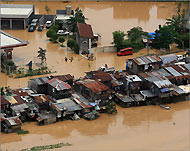Cutting down forests is one of the most important causes of increased floods and landslides (french - archive)
Researchers agree that climate change has some role in the high rate of floods in Asia in general, but without exempting people from his responsibility for destroying the ecological balance and the occurrence of natural disasters of all kinds.
Specialized scientists identify many man-made factors, including - but not limited to - the decline in vegetation cover due to cutting down forests, converting swamps and water marshes into agricultural lands or residential sites, and blocking the natural drainage system with waste and garbage residues.
On this, Ganesh Bangari, the Regional Coordinator for the Water and Swamp Office in Thailand with the International Union for the Conservation of Nature, says that it is not acceptable to always blame nature and climate change, but rather that mankind has a role in blocking and blocking the outlets provided by nature to the excessive rain water and floods.
Bangari believes that good management of flood areas will reduce the human and material losses resulting from natural disasters, as happened in Pakistan recently, stressing the need to protect "the infrastructure of nature, otherwise it is not possible to achieve the requirements of sustainable development."
Part of the floods that hit the Philippines in September 2009 (French - archive)
Justify mistakes
Director of the Manila Institute for Climate and Cities, Reed Costantino, agrees with this opinion, pointing out that climate change - caused by
global warming
- has become the symbol on which officials comment on their mistakes when natural disasters such as floods occur, knowing - and speaking to Costa - that most of the causes leading to floods are of similar Local and well-known nature.
The Filipino researcher stresses that good management in many Asian capitals is the most important issue, whether in terms of waste management or land management and urban distribution, pointing to what the Philippine capital witnessed last year during Tropical Storm Castina and the floods that accompanied it, which killed 400 people.
Costantino singled out some of the behaviors that were building houses in flood plains during the last ten years, destroying forests and spreading waste and garbage that blocked the natural drainage streams of the torrential rainwater, which exacerbated the damage and repercussions of floods year after year.
Real investment
In the same context, environmental researcher Bruce Dunn - who works for the Sustainable Development Department at the Asian Development Bank - sees logging and forest destruction as a major and important reason for increasing the size and risk of floods.
"
Also read:
Climate change ... risks and impacts
"
Dunn recalls a recent study conducted by Australia's Charles Darwin University, which said that a recent 10% decline in forest area contributed to an increase in the frequency of floods from 4 to 28%.
Bangari focuses on this idea by emphasizing investment in natural infrastructure such as forests, rivers, lakes and water marshes, as it is the only way to protect people from the risks of floods or disasters caused by climate change.

